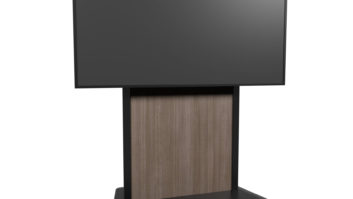Projects Engineer Edwin Bukont was mounting a couple of Asterisk computers (Fig. 1) for use with a new Telos phone hybrid. He came up with a great idea.

When you are forced to mount any heavy computer by yourself, holding and balancing the computer while you try to get rack screws started can be more than frustrating. Ed’s solution was to invert a Middle Atlantic rack shelf and use it as a support for the heavy computers.

Fig. 2 shows a side view of the shelf support, and Fig. 3 is the rear view. The computer slides easily onto the shelf, where it can be secured with rack screws, if desired.

If rack shelves are not available, use a hacksaw to cut the heads off a couple of long rack screws (1 to 1-1/2 inches long). Using the edge of a file (or the hacksaw), cut a slot in the end where you just removed the screw head. This slot will permit a screwdriver to screw this bolt part way into a rack. Screw these bolts where the upper rack mounting screws would be located. Once the bolts are installed in the rack, slide the equipment in place. The protruding prongs of your modified bolts will serve to support the equipment, while you screw in the lower rack screws.
K.M. Richards writes that he’s not much of an engineer (beyond keeping a few low-wattage Class A FMs on the air in the 1980s and a lot of studio audio work during the analog era), but he does keep up by reading Radio World, even when it takes him a few weeks to get to a specific issue.
He says he does this so that, when he consults stations on programming, he can have intelligent conversations with his clients’ engineers. Well, K.M. says this knowledge keeps the engineers from thinking the programming consultant is some kind of uninformed doofus who doesn’t know or care what’s happening at the station, technically.
One of K.M.’s traits that endears him to most engineers is his good organizational skills. K.M. read the May 23 Workbench column, which suggested taking a set of normal readings at the transmitter site. One can certainly record “normal” equipment readings in a book, but K.M. recommends using a label maker to put those readings somewhere near the equipment itself. This enables you to refer to the parameters right on — or close to — the equipment. You don’t have to remember where you put the paper logs or smartphone pictures.
If that’s not practical for any reason, K.M. suggests adding a page to the binder, discussed in the May 23 column, showing the signal paths and listing every piece of equipment with its normal readings. Adding this on the page opposite your rack path diagram simplifies troubleshooting too.
Being prepared is good, writes K.M. Making sure the preparations are nearby so you don’t have to panic to find and use them is even better.
Radio America’s Alan Peterson writes that during demolition and construction of a new kitchen area at its headquarters in Arlington, Va., one of the essentials that vanished was the coffeemaker. It was one of those models that tapped the cold freshwater plumbing under the sink.

When the kitchen disappeared, so did the trickle of black gold that fueled the network’s engineers. An old refillable Bunn-o-Matic was located and set up, but the filter basket was MIA. Rather than see his staff suffer without that mandatory cuppa morning mud, Chief Engineer Curt Flick came up with an inventive solution as shown in Fig. 4.
The plastic cover — stolen from a spindle stack of DVDs — had a drip hole drilled into it and went into service as the filter basket. A plain paper coffee filter was loaded and dropped into the basket, floating off the bottom by a pair of rack ears “borrowed” from a Cisco router. The whole assembly was fastened to the machine above the pot by a hank of wire, normally used to hang suspended ceiling grids. Once in place, it provided coffee for all.
While Alan says he can’t exactly endorse the method to anyone in general — plastic covers and Cisco router ears are not exactly “food-grade” and could prove hazardous — you have to admit, it’s a pretty slick fixit!
Contribute to Workbench. You’ll help fellow engineers and qualify for SBE recertification credit. Send Workbench tips and high-resolution photos to johnpbisset@gmail.com. Fax to (603) 472-4944.
Author John Bisset has spent 48 years in the broadcasting industry and is still learning. He handles western U.S. radio sales for the Telos Alliance. He is SBE certified and is a past recipient of the SBE’s Educator of the Year Award.


